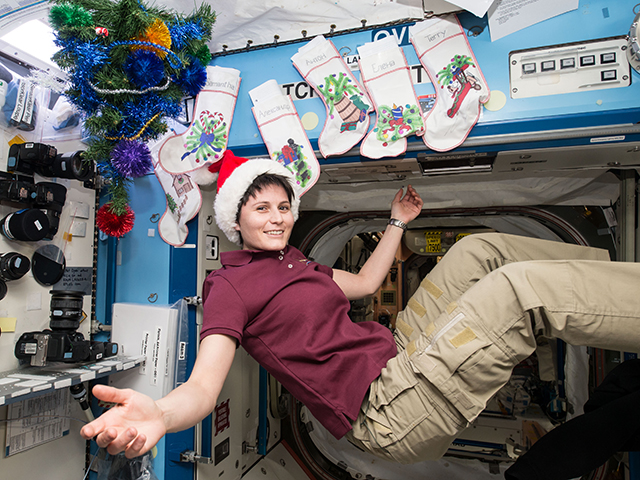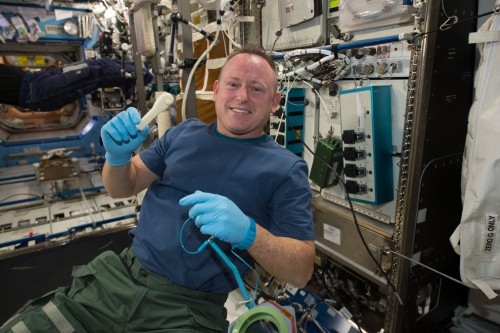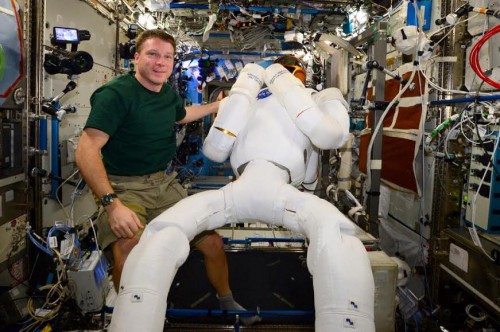
Aboard the International Space Station (ISS), decorated with stockings and a Christmas tree, crew members began this work last week with an adjusted schedule following the postponed SpaceX Dragon CRS-5 delivery. Instead of unloading the capsule, they worked on current research and maintenance. The work ticket last holiday week included studies on plant growth, 3-D print jobs, brain performance studies, and waking up Robonaut for testing.
A 3-D print job for a tool in space was carried out last week by NASA astronaut Barry “Butch” Wilmore for the completion of the first phase of the 3-D Printing in Zero-G Technology Demonstration (3-D Printing in Zero-G). The file for the ratchet wrench was transmitted to the printer on the ISS after being created on Earth. After four hours, 104 layers of extruded plastic built up to create the wrench, which will be eventually returned to Earth to be studied, along with other engineering test objects created with the printer. During this first phase, 13 unique objects were built, with some objects being having multiple copies made. These objects, along with the wrench, will be compared to objects of similar nature that were printed from the same printer before it was sent to the space station. Since the initial phase is now complete, Wilmore took the printer from the Microgravity Science Glovebox (MSG) for storage until it starts the next phase of its operations, due to begin in 2015.

Wilmore also did work this week on the Seedling Growth-2 investigation processing the fourth and last science run on the experiment as part of the Seedling Growth Experiment series. He stowed the experiment in the Minus Eighty-Degree Laboratory Freezer for the International Space Statio (MELFI) for storage until they are able to be returned back to Earth. The Seedling Growth Experiment series uses a small flowering plant, Arabidopsis thaliana, since it is thought of as a model organism. Its goal is to understand how gravity and a variety of light sources affect the growth and proliferation of cells. It is important for gaining knowledge on what plants need to survive in space, and since A. thaliana has simple growth needs and is small, it provides a good model for experiments involving spaceflight.
Results of this experiment have impact on the understanding of how plants can contribute oxygen and be used as a food source on long-duration space travel in the future. It will also help scientists better improve the future of agricultural biotechnology on Earth, which may lead the way toward increased agricultural output.
Robonaut received attention last week from NASA astronaut Terry Virts, when he powered up the robot for mobility testing. Robonaut previously received new processors and climbing legs through a series of upgrades. Virts provided power to the mobile parts of Robonaut since the upgrades were completed.
Robonaut has a humanoid design which allows it to easily work with hardware and in dangerous environments with no risk to astronaut lives, without compromising the adaptability and movement ability humans possess. Now, with its newly added climbing legs, it will be able to perform work in and out of the ISS. The robot resides inside the U.S. lab area on the station, mounted on a stationary device for ease of testing. Its behavior is controlled through the Robonaut Teleoperations System, which makes the robot copy movements crew members make while they are wearing a specially designed set of gloves, a vest, and a visor that lets Robonaut see them three dimensionally through its eyes.

Virts was also busy last week packing trash in Europe’s Automated Transfer Vehicle, which is scheduled to undock from the ISS in February and burn up in Earth’s atmosphere over the Pacific ocean upon its return.
Italian astronaut Samantha Cristoforetti spent time speaking with the president of Italy, Giorgio Napolitano, as he addressed the nation’s military forces. The president commended Cristoforetti for her outstanding participation in the space mission and its importance in providing people with a better understanding of the importance of technology and space research.
Work last week was also done for the Spaceflight Effects on Neurocognitive Performance: Extent, Longevity, and Neural Bases (NeuroMapping) study. Behavioral testing was set up last Tuesday to analyze differences in perception, motor control, memory, and attention taking place in a crew member over the course of a six-month mission in space.
The study is aimed at learning about the changes that long-duration spaceflight causes to happen in the brain. It will use the results from structural and functional magnetic resonance brain imaging (MRI and FMRI) to look at brain structure and function, motor control, and multi-tasking. They will also work to determine the length of time it takes for brain and body recovery from changes that may take place.
Want to keep up-to-date with all things space? Be sure to “Like” AmericaSpace on Facebook and follow us on Twitter: @AmericaSpace



